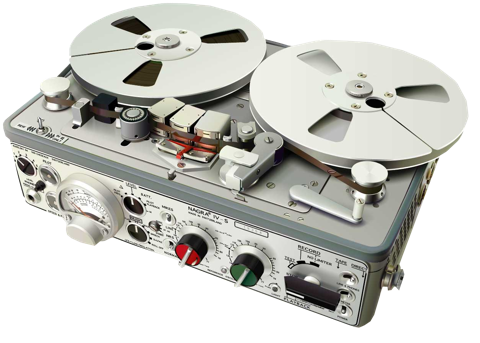Tape Recorders.
Nagra-brand tape recorders were the standard sound recording systems for motion picture and TV production from the 1960s until the 1990s. Their physical appearance, with the single transport selector and large reel to reels are still the sterotypical image most people have of a professional tape recorder. A Nagra recorder prominently appears in the 1981 movie Diva, which features an opera fan making bootleg tapes of his favorite opera singer; another Nagra (a Nagra III) features prominently in the 1981 John Travolta film Blow Out about a freelance sound effects engineer. Another Nagra may be seen in the Beatles' movie Help. The word "nagra" stands for "[it] will record".
The analogue Nagra recorders have a reputation for extreme ruggedness and reliability, essentially being the "Swiss watch" of audio tape recorders. Their cases are highly durable, and every component, from the transport rollers to the gain pots, have the feel of excellent engineering.
- NAGRA I - The very first prototype with clockwork motor and miniature tubes, appearing in 1951. Two were sold to Radio Genève.
- NAGRA II - The first production model, miniature tubes equipped, clockwork motor, appearing in 1953.
- NAGRA II CI - The second generation fitted with printed circuit boards replacing chassis wiring, appearing in 1955.
- Nagra III NP - The first Nagra usable for film work, appearing in 1962.
- Nagra IV-L - Monaural, featuring two microphone inputs and a built in Audio Limiter. Introduced in 1968.
- Nagra 4.2 - Same as the IV-L, but added powering for microphones and built-in equalizers. Introduced in 1972. In the '80s one could upgrade a 4.2 to record SMPTE Timecode.
- Nagra IV-S - Stereo Nagra, recording two-track stereo. It had dual level pots, limiters, and equaliser presets. It was introduced in 1971. Originally it was available with a pilottone crystal, and then in 1984, with timecode support. With timecode support an IV-S became a Nagra IV-STC.
- Nagra IV-SJ - Stereo Nagra for instrumentation and logging. Pots are replaced with switches to set gain in precise steps, no limiters, and when present, the microphone inputs are for high-voltage unbalanced instrumentation mics rather than low impedance balanced with T-power and phantom.

Nagra IV-S. One sexy Tape Recorder!

